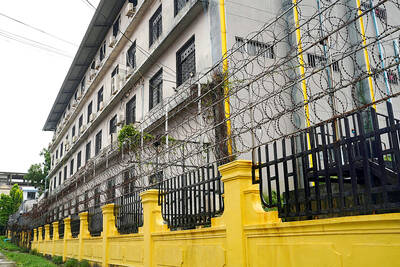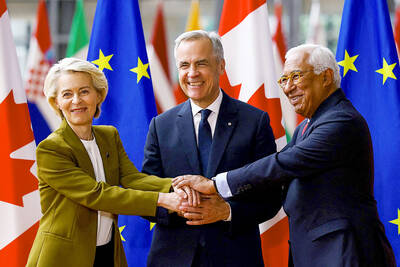Thousands of tonnes of urban waste are hidden behind scrubbed white walls at a new power plant on the outskirts of the Chinese city of Wujiang, with even its chimney disguised as a clock tower.
Desperate to fight mounting trash problems, but wary of public opposition, China is building new incineration capacity designed to blend into its surroundings and limit environmental damage.
Located in sparsely populated farmland about 100km west of Shanghai, with white geese dotting the lake around it on three sides, the Wujiang plant is designed to burn 1,500 tonnes of garbage per day.
It generates heat to run turbines that deliver 500,000 kilowatt-hours of electricity to the power grid at preferential tariffs, about double that of coal-fired plants and the source of two-thirds of its revenue.
“Combustion reduces the volume, turns it into a resource and detoxifies it, so we believe it is going to be a mainstream product within 20 years,” said Cai Shuguang (蔡曙光), deputy general manager of China Everbright International, which built the plant.
With land scarce and consumption surging, China has little choice but to burn as much trash as it can, Cai said.
The landfills encircling Beijing are known collectively as the capital’s “seventh ring road,” while throughout the country burial of untreated waste has contaminated land and built up potentially hazardous pockets of methane.
About 200 trucks dump up to 10 tonnes of trash each day in a silo 26m deep at the Wujiang plant. Toxic emissions are captured and little is wasted, with furnace slag recycled into bricks.
Everbright’s first waste-to-energy plant was built in nearby Suzhou more than a decade ago. China as a whole had 223 such plants by the end of last year, and that number could double by 2020.
However, household waste treatment and recycling rates are still significantly low, China said in a plan published in September, adding that industry spending would need to reach 192.4 billion yuan (US$28.2 billion) from this year to 2020.
The plan aims to incinerate more than 500,000 tonnes of waste per day by then, or 2.5 times the 2014 figure. Better-off cities would have to burn most garbage and curb landfill expansion.
“Waste-to-energy is being encouraged from top to bottom: subsidies are very high and profits far exceed those from recycling,” said Zhao Youcai (趙有才), a waste management expert at Shanghai’s Tongji University.
However, China has struggled to reach previous targets, with daily incineration capacity of 235,224 tonnes by the end of last year missing a goal of more than 300,000 tonnes.
“The main reason is the level of understanding among local governments, and we also need to work on eliminating the problem of ‘Nimbyism,’” Cai said, using an acronym for “Not In My Back Yard.”
Waste incinerators have provoked protest as communities worry about stench and the risk of toxic emissions.
Last week, the Chinese Ministry of Housing and Urban-Rural Development vowed to toughen pollution controls and combat “Nimbyism” by offering cheaper water, heat and electricity for those living near waste projects.
Such moves would transform perceptions to “profit in my backyard” from “not in my backyard,” the ministry said.
China wants to remedy environmental damage caused by three decades of breakneck growth through incentives for private businesses to profit from environmental protection.
It now has fewer low-income “scavengers” to sort garbage in big cities, as rising living standards and falling prices of raw materials have blunted recycling incentives, Zhao said.
“Garbage mountains” and “garbage rivers” litter the countryside, where China aims to treat 90 percent of household waste by 2020.
However, officials have said innovative funding mechanisms are needed.
Subsidy is not a sustainable path, so China must boost market participation, Zhao said.
“Garbage recycling relies on government, and waste-to-energy is subsidized,” he added. “It is a bottomless pit: the amount is just too high and the profits too low.”

Drug lord Jose Adolfo Macias Villamar, alias “Fito,” was Ecuador’s most-wanted fugitive before his arrest on Wednesday, more than a year after he escaped prison from where he commanded the country’s leading criminal gang. The former taxi driver turned crime boss became the prime target of law enforcement early last year after escaping from a prison in the southwestern port of Guayaquil. Ecuadoran President Daniel Noboa’s government released “wanted” posters with images of his face and offered US$1 million for information leading to his capture. In a country plagued by crime, members of Fito’s gang, Los Choneros, have responded with violence, using car

CYBERCRIME, TRAFFICKING: A ‘pattern of state failures’ allowed the billion-dollar industry to flourish, including failures to investigate human rights abuses, it said Human rights group Amnesty International yesterday accused Cambodia’s government of “deliberately ignoring” abuses by cybercrime gangs that have trafficked people from across the world, including children, into slavery at brutal scam compounds. The London-based group said in a report that it had identified 53 scam centers and dozens more suspected sites across the country, including in the Southeast Asian nation’s capital, Phnom Penh. The prison-like compounds were ringed by high fences with razor wire, guarded by armed men and staffed by trafficking victims forced to defraud people across the globe, with those inside subjected to punishments including shocks from electric batons, confinement

The team behind the long-awaited Vera Rubin Observatory in Chile yesterday published their first images, revealing breathtaking views of star-forming regions as well as distant galaxies. More than two decades in the making, the giant US-funded telescope sits perched at the summit of Cerro Pachon in central Chile, where dark skies and dry air provide ideal conditions for observing the cosmos. One of the debut images is a composite of 678 exposures taken over just seven hours, capturing the Trifid Nebula and the Lagoon Nebula — both several thousand light-years from Earth — glowing in vivid pinks against orange-red backdrops. The new image

Canada and the EU on Monday signed a defense and security pact as the transatlantic partners seek to better confront Russia, with worries over Washington’s reliability under US President Donald Trump. The deal was announced after a summit in Brussels between Canadian Prime Minister Mark Carney and European Commission President Ursula von der Leyen and European Council President Antonio Costa. “While NATO remains the cornerstone of our collective defense, this partnership will allow us to strengthen our preparedness ... to invest more and to invest smarter,” Costa told a news conference. “It opens new opportunities for companies on both sides of the